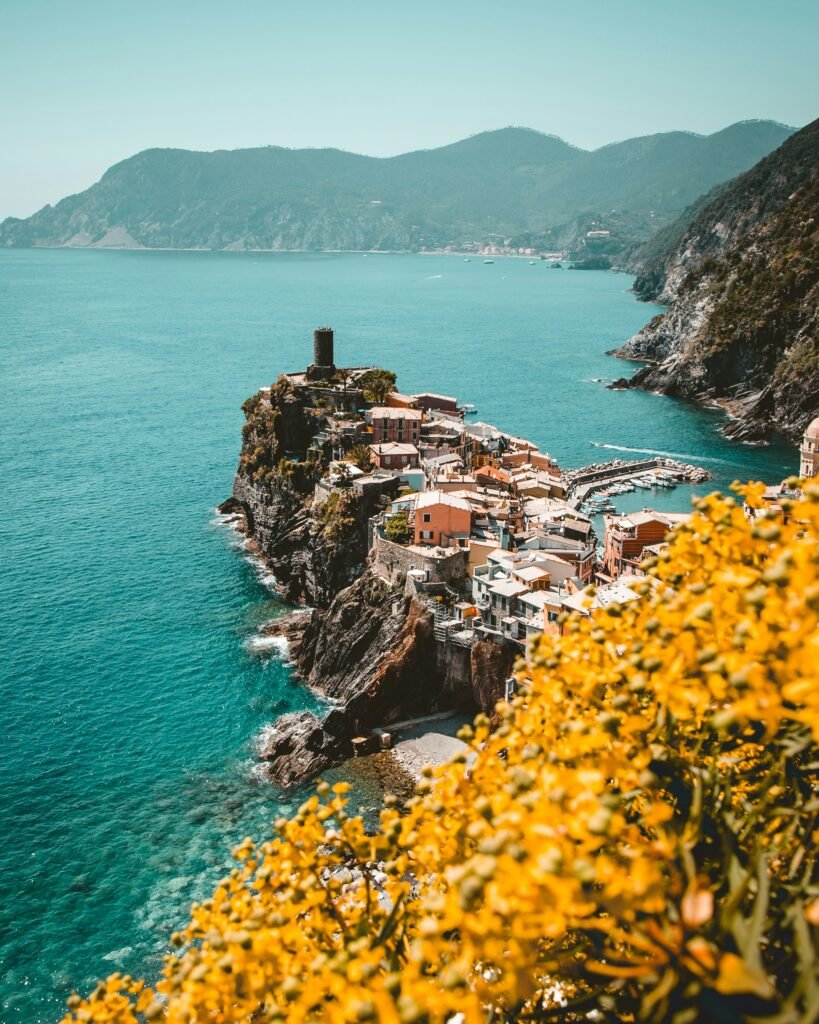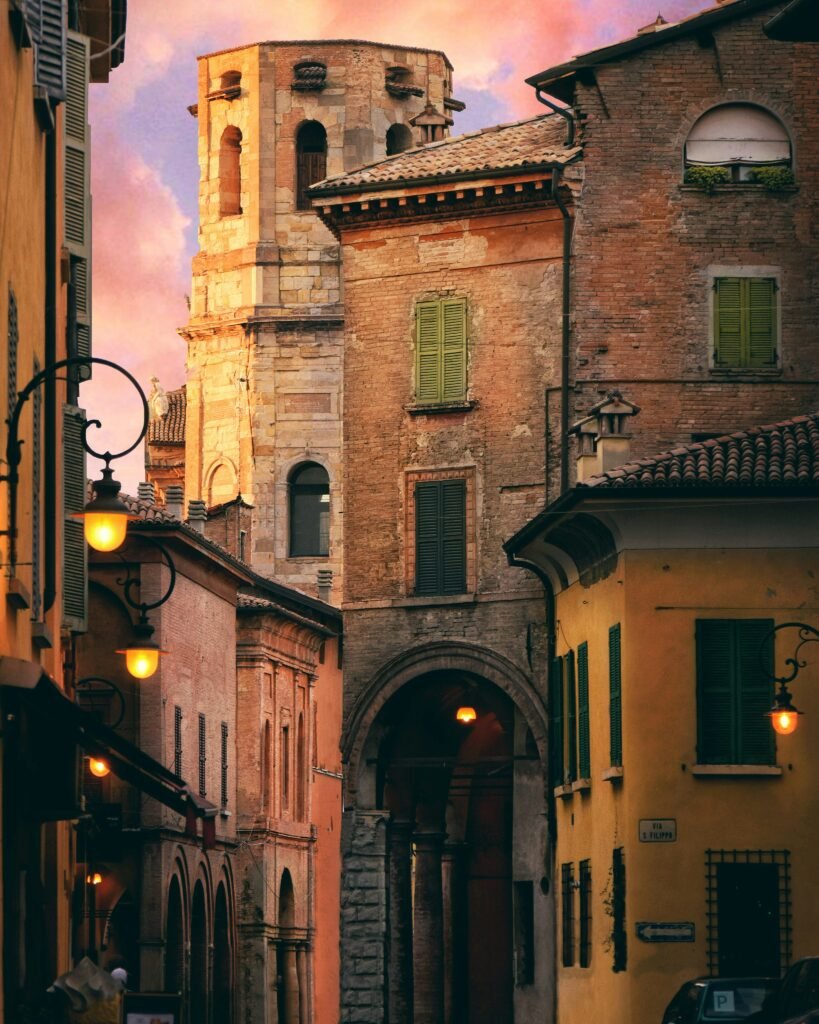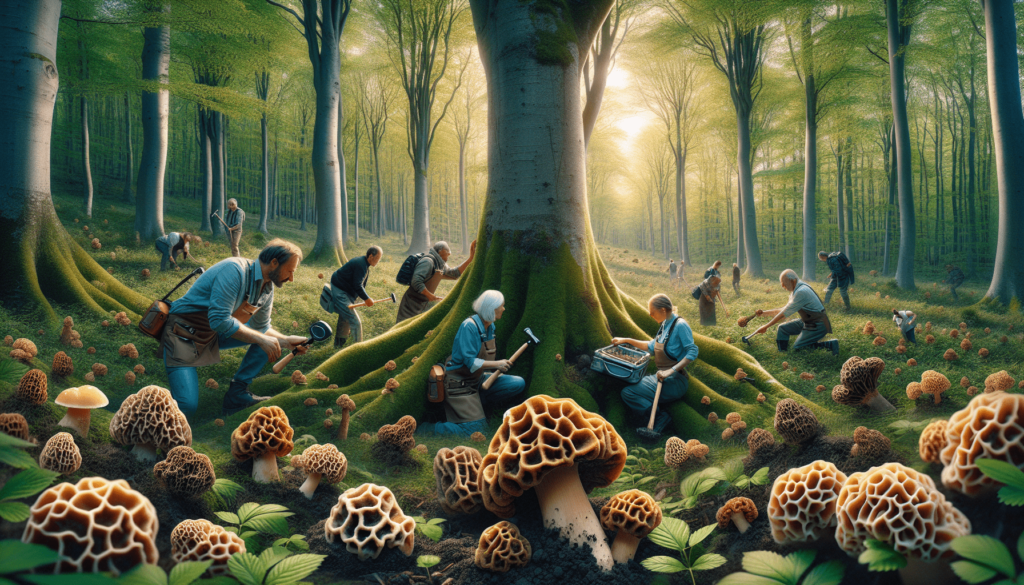Embark on a journey of discovery as you explore Europe’s hidden gems for foraging truffles and morels. Delve into the lush forests and enchanting landscapes of this diverse continent, where ancient woodlands and fertile ecosystems provide the perfect backdrop for mushroom enthusiasts. With detailed regional spotlights and seasonal guides, you’ll uncover the best times and locations to forage for these prized fungi. Along the way, learn about the safety and ethics of foraging, discover essential techniques and tools, and delve into the rich culinary and medicinal traditions surrounding wild mushrooms. Join a vibrant community of like-minded individuals and gain insights into the vital role of conservation and sustainability. Through engaging narratives and personal stories, you’ll be transported into the magical world of mushroom foraging, ready to embark on your own adventure with respect, curiosity, and a sense of wonder. Europe’s hidden gems await, ready to be explored and savored.

Foraging Locations
Exploring the forests of Southern France
When it comes to mushroom foraging, Southern France is a haven for enthusiasts. The lush and diverse forests of Provence offer a bountiful array of edible mushrooms, including the highly sought-after truffles. As you venture into the woodlands of Southern France, you will be surrounded by picturesque landscapes, from rolling hills to dense forests. The region’s Mediterranean climate and rich soil provide the perfect conditions for mushroom growth, making it a prime location for foragers.
Venturing into the woodlands of Italy
Italy is renowned for its rich culinary traditions, and its woodlands are equally renowned for their abundance of wild mushrooms. From the Apennine Mountains to the forests of Tuscany, Italy offers a multitude of foraging locations. As you explore the woodlands, you will encounter a wide variety of mushrooms, including porcini, chanterelles, and the prized truffles. The Italian countryside provides a serene and majestic backdrop for your foraging adventures, offering the perfect balance of nature and culture.
Discovering the treasures of Slovenia
Slovenia may be one of Europe’s best-kept secrets when it comes to mushroom foraging. Its picturesque landscapes, ranging from Alpine forests to karstic caves, offer a diverse range of mushroom species. The country’s unique geographical location and climatic conditions create an ideal habitat for mushrooms to flourish. As you delve into the Slovenian forests, you will have the opportunity to discover a rich variety of mushrooms, from the rare cep to the elusive morel.
Unearthing the hidden gems of Romania
Romania’s mysterious and enchanting forests are a forager’s paradise. With its vast woodlands, including the Carpathian Mountains, it is an undiscovered treasure trove for mushroom enthusiasts. Romania’s diverse ecosystems and temperate climate provide an ideal environment for a wide range of mushroom species. As you embark on your foraging journey through Romania, you will encounter an array of mushrooms, from the delicious chanterelles to the prized morels. The untouched beauty of the Romanian forests will captivate you at every turn.
Regional Spotlights and Seasonal Guides
Diving into the truffle season in Provence
Truffle season in Provence is a much-anticipated time for mushroom enthusiasts. The region’s Mediterranean climate, with its mild winters and hot summers, creates the perfect conditions for truffle cultivation. From December to March, the forests of Provence come alive as expert truffle hunters and their trained dogs set out to unearth these culinary delights. As you explore the truffle trails, you will witness the intricate dance between man, dog, and nature, as they work together to uncover these hidden treasures.
Exploring the enchanting truffle trails of Tuscany
Tuscany is renowned for its exquisite cuisine, and truffles play a starring role in many Tuscan dishes. The region’s forests, with their rich soil and diverse flora, provide an ideal habitat for truffle growth. From September to December, truffle hunters and their loyal dogs embark on a journey through Tuscany’s woodlands, in search of the elusive truffles. As you follow the truffle trails, you will witness the deep-rooted traditions and the unique bond between humans and nature that have made Tuscany a hub for truffle enthusiasts.
Unlocking the ecological secrets of the Slovenian forests
Slovenia’s forests are a treasure trove of biodiversity, and mushrooms play a vital role in maintaining this delicate ecosystem. The country’s diverse landscapes, ranging from Alpine meadows to dense forests, provide a variety of microclimates that support a wide range of mushroom species. From spring to autumn, the Slovenian forests come alive with mushrooms, offering a treat for both foragers and nature enthusiasts alike. As you explore these magical woodlands, you will become a witness to the intricate web of life and the interdependence of species within the Slovenian ecosystem.
Chasing after morels in the Carpathian Mountains
The Carpathian Mountains in Romania are known for their rugged beauty and pristine wilderness. These mountains also serve as a natural habitat for the coveted morel mushrooms. With their distinct honeycomb-like appearance and earthy flavor, morels are highly prized by foragers and chefs alike. From April to June, as the mountains come alive with the arrival of spring, morels emerge from the forest floor, creating a captivating sight for those willing to venture into their domain. As you navigate the trails of the Carpathian Mountains, you will be enthralled by the hunt for these elusive mushrooms and the breathtaking landscapes that surround you.
Safety and Ethics of Foraging
Identifying poisonous mushrooms: a crucial skill for foragers
When it comes to mushroom foraging, one of the most important skills to develop is the ability to identify poisonous mushrooms. While nature’s bounty offers a plethora of delicious and edible mushrooms, there are also species that can cause severe illness or even death if consumed. Therefore, it is essential to familiarize yourself with the distinguishing features of toxic mushrooms and to consult reliable field guides or experts for guidance. By honing your identification skills, you can ensure a safe and enjoyable foraging experience.
Respecting wildlife habitats and leaving no trace
Foraging is a privilege that comes with the responsibility to protect and preserve the natural environment. It is crucial to respect wildlife habitats and leave no trace while exploring the forests. This means avoiding unnecessary damage to vegetation, not disturbing wildlife, and refraining from littering. By minimizing your impact on the ecosystem, you can contribute to its sustainability and ensure that future generations can also partake in the joys of mushroom foraging.
Understanding local regulations and permits
When foraging in different regions, it is important to be aware of local regulations and obtain any necessary permits. Some areas may have specific rules regarding mushroom foraging, including restrictions on the collection of certain species or designated foraging seasons. By familiarizing yourself with these regulations and adhering to them, you can ensure that your foraging activities are legal and sustainable.
Promoting ethical foraging practices
Ethical foraging goes beyond following rules and regulations; it is about developing a deep respect for nature and its fragile balance. It involves harvesting mushrooms responsibly, only collecting what you will use, and avoiding overexploitation. Ethical foragers also prioritize the health of the ecosystem, considering the impact their actions may have on the overall biodiversity. By promoting and practicing ethical foraging, you can contribute to the long-term sustainability of mushroom habitats and preserve these natural treasures for future generations.
Foraging Techniques and Tools
Choosing the right basket for mushroom collection
When venturing into the forest, having the right tools can greatly enhance your foraging experience. One essential tool for collecting mushrooms is a basket. Opting for a basket with an open structure allows air to circulate, preventing your harvest from becoming soggy and preserving their quality. The basket should also have a handle or straps for easy carrying, as well as a solid bottom to prevent smaller mushrooms from falling through. By choosing the right basket, you can ensure that your mushrooms stay fresh and protected during your foraging expeditions.
Utilizing technology: mushroom identification apps
In the age of technology, mushroom identification apps have become valuable tools for foragers. These apps use visual recognition technology to help identify different species of mushrooms, providing beginners with a reliable resource in the field. From detailed descriptions and images to habitat and edibility information, these apps can assist foragers in making informed decisions about the mushrooms they encounter. However, it is important to remember that while these apps can be helpful, they should not be solely relied upon for identification. It is crucial to cross-reference with field guides or consult experienced foragers to ensure accuracy.
Mastering the art of mushroom hunting
Mushroom hunting is as much an art as it is a science. It requires patience, observation, and a keen eye for detail. Learning from experienced foragers and mycologists can greatly enhance your skills. They can teach you how to recognize the subtle differences in mushroom characteristics, such as color, texture, and odor. Additionally, understanding the ecological relationship between mushrooms and their surroundings can help you narrow down potential foraging spots. With time and practice, you will become adept at navigating the forest and discovering the hidden treasures it holds.
Learning from experienced foragers
The wisdom and knowledge passed down from experienced foragers are invaluable resources for those embarking on their own foraging journeys. Whether it is through joining foraging workshops, attending festivals, or simply engaging in conversation with experienced foragers, these interactions can provide insights into the best foraging techniques, secret spots, and safety precautions. The shared experiences and stories of seasoned foragers can spark inspiration and deepen your understanding of the intricacies of mushroom foraging. By tapping into this collective wisdom, you can enrich your own foraging practice and become part of a vibrant community.

Culinary and Medicinal Uses
Exploring truffle-infused delicacies in French cuisine
Truffles are revered in French cuisine for their unique and exquisite flavors. From shaved truffles on pasta to truffle-infused oils and butters, these culinary treasures add a touch of luxury to any dish. Provence, in particular, is known for its truffle delicacies, with restaurants and markets showcasing the region’s abundant harvest. By incorporating truffles into your cooking, you can experience the depth and earthiness that these fungi bring to the table, and immerse yourself in the gastronomic culture of Southern France.
Uncovering the medicinal properties of morels
Morels not only tantalize our taste buds but also offer potential health benefits. These mushrooms are rich in nutrients, including vitamins, minerals, and antioxidants. Some studies suggest that morels may have anti-inflammatory and antibacterial properties, making them a valuable addition to traditional medicine practices. Whether used in teas, extracts, or incorporated into culinary creations, morels offer a unique combination of flavor and potential health benefits.
Traditional Italian recipes featuring wild mushrooms
Italy’s culinary traditions are deeply intertwined with wild mushrooms, and exploring these traditional recipes is a delightful way to immerse yourself in the flavors and culture of the country. From creamy risottos with porcini mushrooms to hearty pasta dishes bursting with the flavors of chanterelles, wild mushrooms are celebrated ingredients in Italian cuisine. By preparing these traditional recipes, you can experience the authentic taste of Italy and gain a deeper appreciation for the art of mushroom foraging.
Slovenian mushroom dishes: a taste of local culture
In Slovenia, mushrooms hold a special place in the country’s culinary heritage. From hearty mushroom soups to traditional dishes like “štruklji” (rolled dumplings) filled with mushrooms, Slovenian cuisine showcases the versatility and richness of these fungi. By exploring Slovenian mushroom dishes, you can not only savor the unique flavors but also gain insight into the cultural significance of mushrooms in Slovenian society. Food becomes a gateway to understanding local traditions, connecting with the people, and immersing yourself in the vibrant tapestry of Slovenian culture.
Community and Culture
Joining foraging workshops and festivals
Foraging workshops and festivals offer a unique opportunity to connect with like-minded individuals and learn from experienced foragers and experts. These gatherings bring together mushroom enthusiasts from all walks of life, creating a supportive and inclusive community. From hands-on demonstrations and educational sessions to guided forays into the forest, these events provide a platform for sharing knowledge, fostering friendships, and igniting a passion for mushroom foraging. By participating in these workshops and festivals, you can embark on a shared journey of exploration and discovery.
Connecting with local foraging communities
One of the joys of mushroom foraging is the sense of community that can be found within local foraging groups. These groups often consist of passionate individuals who come together to share their love for mushrooms and the natural environment. They organize group forays, share knowledge, and collectively contribute to the preservation of mushroom habitats. By connecting with these communities, you can build lasting friendships, expand your knowledge, and be part of a collective effort to promote sustainable foraging practices.
Discovering the cultural significance of mushrooms
Mushrooms hold a deep cultural significance in many societies around the world. From ancient folklore to traditional healing practices, mushrooms have been revered and celebrated for centuries. By delving into the cultural history of mushrooms within the regions you are exploring, you can gain a deeper appreciation for the role these fungi play in shaping local traditions and beliefs. Whether it is through storytelling, art, or traditional ceremonies, the cultural significance of mushrooms adds a layer of enchantment to your foraging experiences.
Sharing foraging experiences and knowledge
Foragers are inherently curious individuals who are constantly learning and discovering. Sharing your foraging experiences and knowledge with others can be a rewarding way to give back to the community and inspire fellow enthusiasts. Whether through social media, online forums, or local gatherings, your experiences and insights can contribute to the collective wisdom of the foraging community. By fostering an environment of sharing and collaboration, you can help ignite the passion for mushroom foraging in others and create a ripple effect of appreciation for these natural wonders.

Conservation and Sustainability
Understanding the ecological role of truffles and morels
Truffles and morels play integral roles in the ecosystems they inhabit. They form symbiotic relationships with trees, assisting in nutrient exchange and supporting overall forest health. Truffles, in particular, have a unique relationship with certain tree species, relying on their root systems for survival. By understanding the ecological significance of these mushrooms, foragers can become advocates for their conservation and play a role in preserving these delicate ecosystems. By recognizing the intricate web of life that mushrooms contribute to, foragers can become stewards of the environment.
Promoting sustainable foraging practices
Sustainability should be at the forefront of every forager’s mind. This means harvesting mushrooms responsibly, avoiding over-collection of rare or vulnerable species, and leaving enough mushrooms behind to allow for future growth. It also involves not damaging the habitat or disturbing sensitive ecosystems during the foraging process. By promoting sustainable foraging practices, foragers can ensure the long-term viability of mushroom populations and contribute to the overall health of the natural environment.
Supporting conservation initiatives
Conservation initiatives and organizations play a crucial role in safeguarding mushroom habitats and raising awareness about their ecological importance. By supporting these initiatives through donations, volunteering, or participating in citizen science projects, foragers can make a tangible impact on the preservation of mushroom ecosystems. These efforts help protect biodiversity, promote scientific research, and contribute to the overall understanding of the natural world.
Preserving mushroom habitats for future generations
Foragers are not only immersed in the present beauty of mushroom habitats but are also responsible for ensuring their preservation for future generations to enjoy. This involves being mindful of the impact of foraging activities, respecting designated protected areas, and actively participating in restoration efforts. By preserving mushroom habitats, foragers can ensure that these natural treasures continue to flourish, providing endless opportunities for exploration, culinary delights, and a deep sense of connection to the natural world.
Engaging Narratives and Personal Stories
Anecdotes from experienced truffle hunters
Experienced truffle hunters have countless stories to share about their adventures in the forests. These anecdotes offer a glimpse into their unique experiences, capturing the excitement, challenges, and triumphs that come with hunting for these elusive treasures. From serendipitous discoveries to heart-pounding moments of anticipation, these personal narratives bring the magic of truffle hunting to life and inspire readers to embark on their own foraging expeditions.
Personal tales of morel foraging adventures
Morel foraging adventures often lead to unforgettable experiences in the wilderness. Each forager has their own story to tell, whether it is stumbling upon a hidden patch of morels or navigating treacherous terrain in search of these prized mushrooms. These personal tales evoke the thrill of the hunt and the sense of wonder that comes with uncovering nature’s hidden gems. By sharing these stories, foragers can transport readers into the heart of the forest and inspire them to embark on their own morel foraging journeys.
Insights from local mycologists and experts
Local mycologists and experts offer a wealth of knowledge about the mushrooms and ecosystems within the regions they study. Their insights into the behavior of mushrooms, the interconnections within ecosystems, and the cultural significance of fungi provide a deeper understanding of the world of foraging. By sharing these insights, mycologists and experts not only educate but also instill a sense of wonder and appreciation for the natural world. Their expertise enriches the foraging experience, making it a holistic and transformative endeavor.
Inspirational stories from passionate foragers
Passionate foragers have stories that go beyond the harvest itself. These stories capture the essence of what it means to be deeply connected to the land and the joy that comes from exploring nature’s hidden corners. From personal transformations to a renewed appreciation for the beauty of the natural world, these inspirational stories ignite a spark within readers, motivating them to seek out their own foraging adventures. By sharing these stories, passionate foragers become ambassadors for the wonders of mushroom hunting and the joy it brings to those who embark on this rewarding journey.
In conclusion, the art of mushroom foraging is a captivating and enriching endeavor that connects us with the natural world and our culinary heritage. Each location offers its own unique rewards and challenges, providing a rich tapestry of experiences for foragers to explore. By embracing safety and ethics, honing foraging techniques, appreciating culinary and medicinal uses, fostering community and culture, prioritizing conservation and sustainability, and sharing engaging narratives and personal stories, foragers can embark on a transformative journey of exploration and discovery. So, grab your basket, lace up your boots, and set forth into the forests of Europe’s hidden gems to uncover the treasures that lie beneath the forest floor. Happy foraging!

